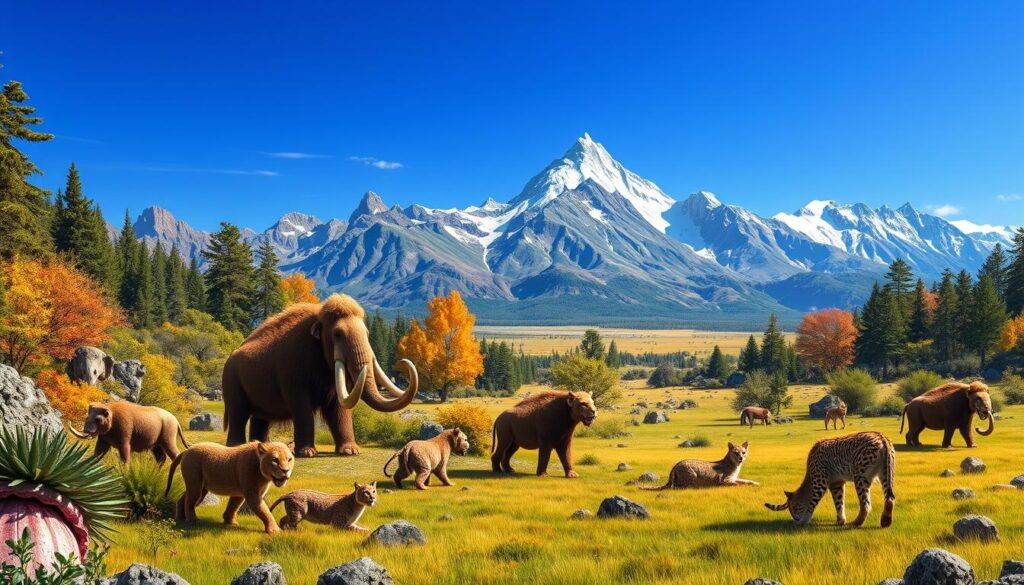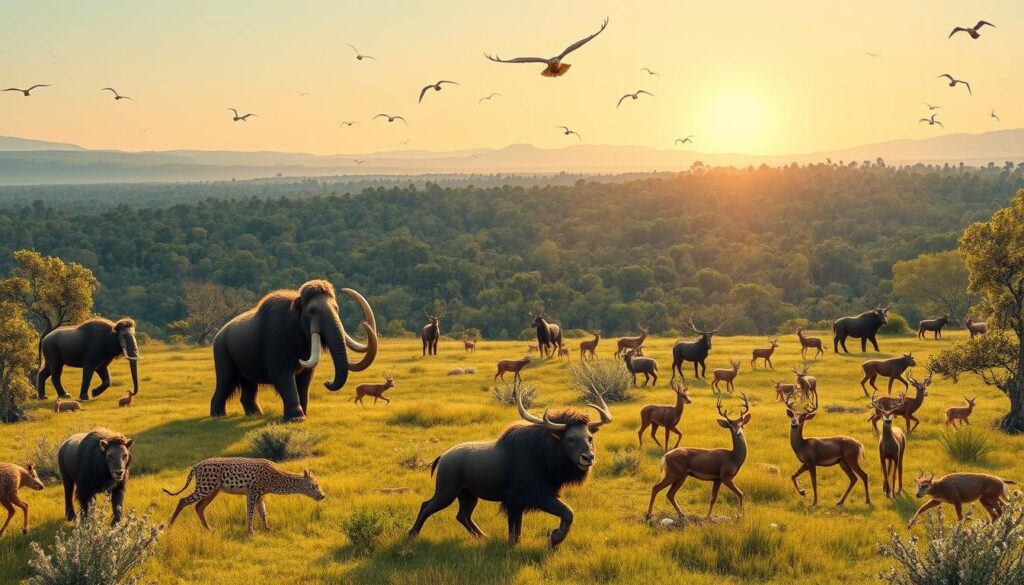
“Vibrant prehistoric landscape showcasing diverse fauna and flora of the Cenozoic era, featuring mammoths and saber-toothed cats roaming alongside ancient forests and lush grasslands, with majestic mountains in the background under a clear blue sky.”
The Cenozoic era is the latest chapter in Earth’s history, starting about 65 million years ago. It’s the time when our planet changed a lot. This era shaped the landscapes, ecosystems, and life forms we see today.
This era is known as the “Age of Mammals.” It’s when mammals quickly spread and became the top species. We see animals like elephants, whales, and primates, including humans, today.
The Cenozoic also saw the creation of many familiar landscapes and weather patterns. This happened as the Earth’s tectonic plates moved and changed the surface.
Key Takeaways
- The Cenozoic era spans from approximately 65 million years ago to the present day.
- This era is marked by the rise of mammals and the evolution of modern landscapes and ecosystems.
- The Cenozoic has witnessed significant changes in the Earth’s geology, climate, and life forms.
- Understanding the Cenozoic era provides important insights into the formation of the modern world.
- Exploring the Cenozoic era is crucial for understanding the geological timeline and the development of our planet.
Unveiling the Cenozoic: An Era of Transformation
The Cenozoic era, lasting 65 million years, has seen huge changes on Earth. Known as the “Age of Mammals,” it’s when modern species emerged. This era shaped the world we live in today.
Defining the Cenozoic Era
The Cenozoic era is split into two main periods: the Tertiary and the Quaternary. The Tertiary, from 65 million years ago to 2.6 million years ago, brought many mammal species. The Quaternary, from 2.6 million years ago to now, has seen big climate changes and the rise of humans.
Significant Events and Changes
The Cenozoic era has seen many key events. Dinosaurs went extinct, making way for mammals. These mammals quickly spread out and filled different environments.
Landmasses like South America and Africa separated, and mountains like the Himalayas rose. These changes greatly altered Earth’s surface and climate.
The era also saw big climate shifts, from very warm to very cold. These changes greatly affected life on Earth. They led to the emergence of many species we know today.
The Cenozoic era has been a time of huge change. It’s when dinosaurs disappeared and mammals took over. It’s also when our continents took shape. This era has deeply influenced our planet’s history.
Life in the Cenozoic: Evolution Unleashed

A vibrant Cenozoic landscape teeming with diverse fauna, featuring towering mammoths and saber-toothed cats roaming lush grasslands, accompanied by giant ground sloths, and agile deer; in the background, a sprawling forest filled with early horses and birds soaring in the clear blue sky, all under the warm glow of a setting sun.
The Cenozoic era started about 65 million years ago. It was a time of big changes in plants and animals. Mammals, plants, and many species we know today began to evolve.
At first, mammals were small and not very noticeable. But they grew and changed a lot. They became everything from tiny rodents to huge mammoths and fierce tigers. This was because dinosaurs had died out, leaving space for mammals to grow.
Primates, including our human ancestors, also evolved during this time. They lived in different places, like forests and savannas. This shows how adaptable life was during the Cenozoic era.
Plants also changed a lot. Flowering plants and different plant groups became more common. This led to more varied landscapes, helping life to thrive.
| Cenozoic Era Ecosystem | Dominant Flora | Dominant Fauna |
|---|---|---|
| Grasslands | Grasses, shrubs, and herbs | Grazing mammals, such as horses, bison, and deer |
| Forests | Flowering trees, ferns, and conifers | Arboreal mammals, such as primates and rodents, as well as various bird species |
| Wetlands | Aquatic plants, such as reeds and water lilies | Waterfowl, reptiles, and amphibians |
The changes in life during the Cenozoic era helped create our modern ecosystems. Learning about these changes helps us understand how life on Earth adapts and survives.
Cenozoic Climate: A Rollercoaster Ride
The Cenozoic era, which started 65 million years ago, has seen big changes in the climate. Earth’s weather went from being very warm to very cold. This change has shaped the world we see today.
Periods of Warmth and Cooling
During the Cenozoic, Earth went through times of high temperatures and high levels of carbon dioxide. Then, it went through periods of cold, with glaciers and ice sheets growing. These changes were caused by many factors, like the Earth’s orbit, the sun’s energy, and volcanoes.
Impact on Earth’s Ecosystems
The climate changes of the Cenozoic greatly affected Earth’s ecosystems. Plants and animals had to adapt, move, or sometimes disappear. The rise of mammals and birds, and the growth of grasslands, are all thanks to these changes.
Important Point
| NO. | Important Points |
| 1. | About Us |
| 2. | Contact Us |
| 3. | Disclaimer |
| 4. | Privacy Policy |
FAQs of Cenozoic
What is the Cenozoic era?
The Cenozoic era is the most recent geological period. It started about 65 million years ago and continues to today. This era saw big changes, like mammals becoming more common and landscapes evolving into what we see today.
What are the key events and changes that defined the Cenozoic era?
The Cenozoic era is split into two periods: the Tertiary and the Quaternary. Dinosaurs went extinct, and mammals rose to power. Modern continents formed, and climate changed a lot. This era also saw the growth of complex ecosystems.
How did life evolve during the Cenozoic era?
Life changed a lot during the Cenozoic era. Mammals became more diverse, and plants and animals evolved. Early mammals and modern primates emerged. This led to the complex ecosystems we have today.
What were the major climate changes during the Cenozoic era?
The Cenozoic era saw big climate shifts. There were warm periods and ice ages. These changes affected ecosystems, shaping the life we see today.
How did the Cenozoic era shape the modern world?
The Cenozoic era set the stage for our world. Events like dinosaur extinction and mammal rise shaped our landscapes and ecosystems. These changes created the world we know today.
See these too
- Read Also: Discover Butte: Montana’s Historic Mining City
- Read Also: Calcarenite: The Fascinating Limestone Rock
